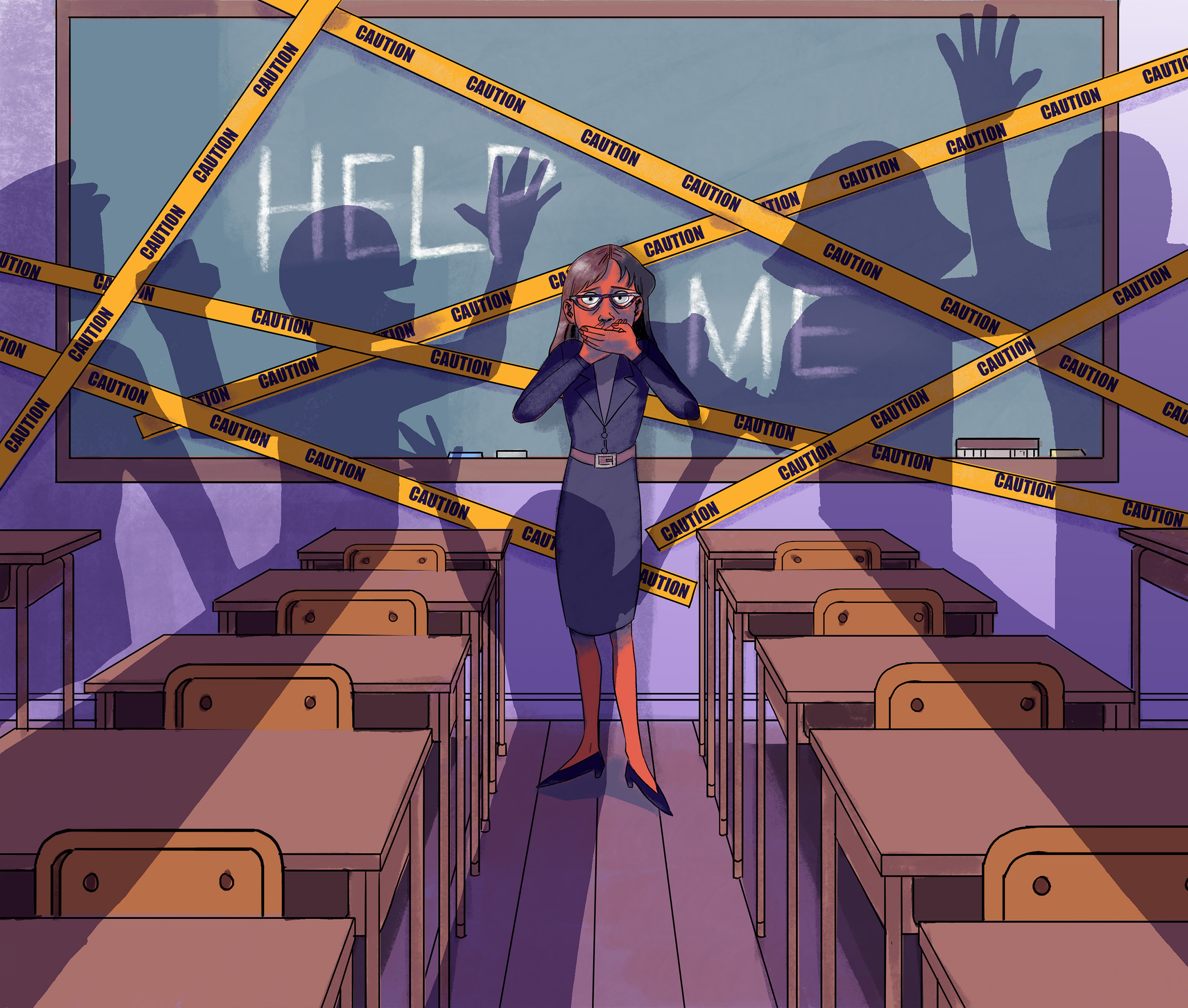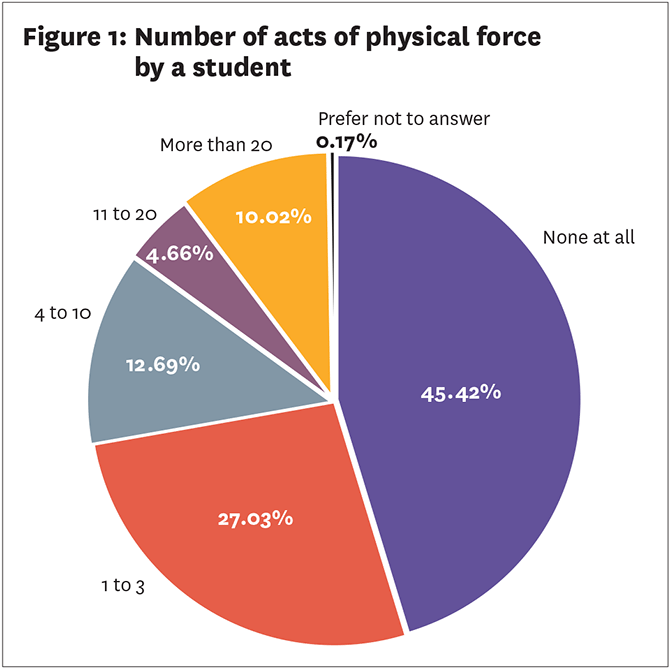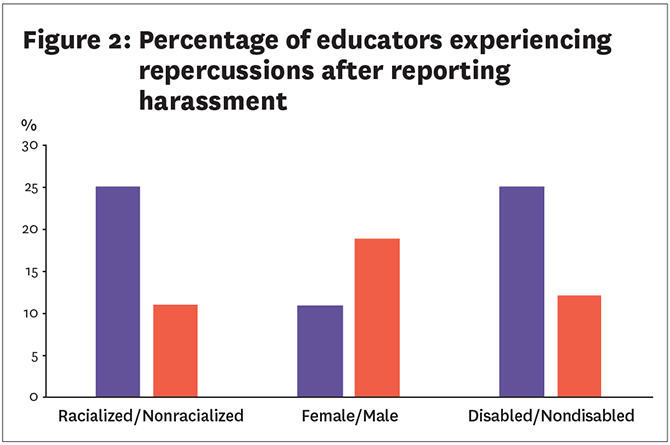The Dirty Little Secret
Harassment and violence against educators

“Teachers should not feel that it’s normal to feel unsafe at school.”
– Special education resource teacher
Violence in schools is usually framed in relation to student-on-student bullying, but schools are also workplaces for (predominantly women) teachers and educational assistants: workers who are entitled to – but do not always experience – a safe and violence-free workplace. Over the last decade, unions representing education workers have mobilized to shed light on the “dirty little secret” of educator-directed violence, and the issue has received a measure of media attention. Surprisingly, however, while there are numerous studies examining peer-on-peer violence among students, the harassment and violence experienced by educators has received limited scholarly attention. Indeed, while research on bullying, harassment, and violence against students number in the thousands, we were able to locate less than ten studies on educator-directed harassment and violence in Canada.
To start to address this gap in the scholarly literature, we surveyed 1,688 Ontario English public elementary school educators (contract and occasional teachers, PSP/ESPs, ECEs/DECEs, and other educational professionals) in December 2018 about their experiences of workplace harassment (e.g. slurs, insults, and put-downs) and violence (i.e. acts, attempts, and threats of physical aggression) in the 2017-2018 school year. The Harassment and Violence against Educators (Ontario) Survey endeavoured to assess the frequency, impact, and response to harassment and violence against educators as well as to determine how experiences of, and the response to, harassment and violence are impacted by intersecting factors such as gender, dis/ability, and racialization.
Our full report, Facing the Facts: The escalating crisis of violence against educators, can be downloaded at www.educatorviolence.net. Below, we have summarized select key findings.
- Most harassment and violence experienced by educators in Ontario’s public elementary schools is student-initiated and rates are alarmingly high. Fifty-four percent of educators reported experiencing one or more acts of student-initiated physical violence during the 2017-2018 school year; 60% reported one or more attempts to use physical force, and 49% experienced one or more threats. (See Figure 1.) In terms of harassment, 72% of educators reported experiencing explicit verbal insults, put-downs, and/or obscene gestures from a student in the 2017-2018 school year.
- Results of the study suggest that there has been an almost ten-fold increase in the experience of violence against educators since the first Canadian surveys were conducted some two decades ago. Results from a 1999 study on behalf of the British Columbia Teachers Federation1 showed that fewer than 5% of educators experienced some form of physical violence during the 1997–98 school year – approximately one-tenth of the rate indicated in the current study.
- Harassment and violence against elementary school educators is gendered violence. Not only are upwards of 85% of elementary school educators women, but gender is evident in the nature of the violence (language deployed, the mobilization of gendered tropes, microaggressions, and sexual harassment) and in the institutional response, including the routine responsibilizing and blaming of educators for the harassment and violence they experience.
- Vulnerability to harassment and violence is conditioned by intersecting factors. For example, rates of harassment and violence from students are statistically higher among educators identifying as racialized, disabled, women, or LGBTQ2+; they also experience elevated levels of reprisals from their administrators. (See Figure 2.) Women with disabilities experience the highest levels of harassment and violence.
- Harassment and violence are often repetitive, frequent, and ongoing occurrences. Educators who experience harassment report an average of 8.5 occasions of insults, put-downs, or obscene gestures from students, 2.77 from parents, 3.98 from colleagues, and 4.21 from administrators in the 2017-2018 school year.

- Qualitative data reveals that educators often feel unsupported by administrators, that common strategies such as requiring educators to wear personal protective equipment (e.g. spit shields, concussion caps, or Kevlar arm and shin guards) are addressing symptoms rather than root causes, and that there is a disturbing normalization of violence in Ontario’s elementary schools.
- The impact of harassment and violence is long lasting. Higher levels of harassment and violence are associated with decreased physical and mental health as well as job performance, even when assessed some six months after the school year in which the harassment and violence occurred.
- Almost half of educators (47%) did not report their worst incident of workplace violence in the past year. Reasons for not reporting included a lack of time, being dissuaded from doing so, and concern about repercussions.
- Only 36% of educators were confident in their ability to deal with an incident of physical violence; the majority would welcome social-emotional learning programs (68%) and non-physical intervention training (55%).
- The financial impact associated with harassment and violence is considerable. Educators reported taking an average of 6.84 days off work following their worst instance of harassment in the 2017-2018 school year and an average of 5.18 days off work following their worst instance of physical violence. The costs associated with lost time due to harassment and violence against public school educators in Ontario are conservatively estimated to be in excess of 3 million dollars annually.2
- Educators overwhelmingly identified the need for more and better allocation of physical and human resources (e.g. educational assistants, mental health specialists) and earlier identification of student needs. They also noted the importance of additional educational resources, clear policies that are followed, consistently applied consequences for violent and harassing behaviour, and better trained, more responsive and supportive administrators.
The escalating crisis
“I love teaching… However, the emotional and mental abuse that I have been subjected to on a daily basis, and the physical toll it has been taking on my body is unbelievable… I took a medical leave from work due to the stress and abuse. I learned that [my health issues] are due to a prolonged exposure to these conditions.” – Grade 2 French Immersion teacher
The 2017-2018 Harassment and Violence against Educators (Ontario) Survey provides stark evidence that educator-directed harassment and violence is escalating and quickly becoming a crisis. Indeed, rates of harassment and violence are critically high. In a single year, as many as one in two educators will experience violence and as many as 70% will experience harassment, whether from a student, parent, colleague, or administrator. Moreover, harassment and violence are increasing dramatically. Rates of harassment have at least doubled, and rates of physical violence have increased seven- to ten-fold over the last two decades. At the same time, we see a disturbing normalization of violence against educators by administrators, educators, and students operating in tandem with the widespread minimization and/or denial of its multifaceted impacts by administrators, school boards, and politicians. In addition, findings from the Harassment and Violence against Educators (Ontario) Survey indicate that workplace violence is being underreported, and when reported, is all too often accompanied by blame and reprisal. This suggests that official rates underestimate the true prevalence and speaks to an organizational culture that is ill-equipped to address the issue. In real terms, while school boards have embraced the language of progressive discipline mandated under the provincial Education Act, educators told us that, in practice, there are few consequences for students’ harassing and violent behaviour. Finally, findings from the current study suggest that many educators feel neither adequately supported nor prepared and trained to deal with the student-initiated harassment and violence that they are experiencing.
Rates of harassment have at least doubled and rates of physical violence have increased seven- to ten-fold over the last two decades.
The escalating crisis of educator-directed harassment and violence speaks to the compounding impact of structural, fiscal, and social factors. The past 20 years have seen significant changes in society, including growing income disparity, social inequality, and economic stress, a rise in both moderate and severe mental health difficulties among children,3 and the ubiquity of electronic devices, all of which have increased the needs of students. At the same time, we have seen significant shifts in provincial education policies, including a commitment to mainstreaming (placing students with complex needs in regular classrooms with correspondingly decreased use of segregated classrooms) institutionally structured “corrective and supportive” progressive discipline policies,4 and ministry-mandated “Learning for all”5 approaches based on the recognition that “all students learn best when instruction, resources, and the learning environment are well suited to their particular strengths, interests, needs, and stage of readiness.”6 To be successful, these evidence-based practices require significant investment in infrastructure, materials, professional development, and human resources. Unfortunately, as needs and expectations increase, funding formulas have not been recalibrated. Indeed, in Ontario, the impact of deep funding cuts introduced under the Mike Harris government (1995 to 2002) continues to echo.7 In classrooms across Canada, educators are scrambling to meet ever-expanding expectations – from more Individual Education Plans to increased class size to standardized testing requirements – with decreasing levels of support and resources. The result is entirely predictable – frustrated, struggling children whose needs are not being met are “lashing out.”

Harassment and violence, coupled with inadequate (and potentially declining) resources to meet the needs of students, the normalization of harassment and violence against educators, a fear of reprisal for reporting, low levels of support, increasing levels of incivility, the uncertainty about how to effectively respond to harassment and violence, and an unwillingness on the part of administrators to consequence aggressive behaviour is having detrimental impacts on the classroom learning environment, students, and the health and well-being of educators. Indeed, in light of the high rates of harassment and violence experienced by educators in the performance of their duties, it is reasonable to expect that most educators will suffer a mental injury (e.g. PTSD, burnout) at some point in their careers. Accordingly, in addition to strategies to reduce harassment and violence in schools, it is essential that adequate resources (such as access to mental health professionals) are available to ensure that educators who experience harassment and violence have the opportunity to address any mental or physical injuries they sustain, as well as to learn the skills needed to cope with ongoing exposure to harassment and violence.
Action is needed
Addressing this significant problem will require a commitment to immediate action, including:
- Increased resources to ensure that the most vulnerable students are getting the help they need and that all students have access to the supports they require to flourish and learn. This will require, among other things, augmented health services (e.g. early diagnosis and interventions), more educational assistants and other educational supports, and smaller classes to facilitate the individualized attention mandated by provincial education legislation.
- Support for teachers to enable them to manage the increasing breadth and intensity of needs in their classrooms, and resources to address educators’ mental and physical health needs in the context of the escalating harassment and violence they are experiencing.
- Training for administrators to ensure that they have the skills to adequately address harassment and violence in schools and provide meaningful support to educators who experience harassment and/or violence.
- Ensuring that policies and protocols concerning harassment and violence are understood and consistently applied, including the implementation of student consequences that are appropriate and effective.
- Ongoing monitoring of workplace harassment and violence and the development of strategies to address the heightened vulnerability of designated groups, such as racialized, Indigenous, disabled, women, and LGBTQ2+.
- Adoption of a population health approach that examines and addresses the broad range of factors influencing harassment and violence against educators.
The workplace violence educators experience has significant and far-reaching costs. It impacts educators’ health, well-being, careers, ability to do their jobs, and relationships. In real terms, the violence reverberates through their personal and professional lives and in turn though the lives of their families, their colleagues, and the students they teach – creating ever more ripples that impact other families and indeed the broader community and society. The impacts also ripple over time – we can only imagine how the casual normalization of violence against (predominantly women) educators is shaping the perceptions and expectations of a generation of students.
Illustration: Diana Pham
First published in Education Canada, September 2020
Notes
1 David R. Lyon and Kevin S. Douglas, Violence Against B.C. Teachers: Report of the Simon Fraser University/British Columbia Teachers’ Federation violence against teachers survey (Burnaby, B.C.: SFU Mental Health, Law and Policy Institute, 1999).
2 The financial costs associated with days of work following an incident of harassment and violence were calculated in the following manner. Assuming a conservative rate of violence or harassment that would require time off work, of say just 10% (which is less than one fifth of the rate reported in this survey), then it can be expected that some 8,000 educators would have taken time off work at the time that the survey was conducted. If 25% of those 8,000 educators took the average number of 6.84 days off work, the average cost of replacing these educators in the classroom would be $1,652.31 each, amounting to over 3 million dollars annually. It is important to keep in mind that this estimates a very low rate of exposure to harassment and violence and estimates only the replacement costs associated with a single incident of harassment (and not violence) in any given year. It is important to keep in mind that educators in this survey reported multiple instances of violence and harassment in a single year.
3 A. Boak, H. A Hamilton, et al., The Mental Health and Well-being of Ontario Students, 1991-2017: Detailed findings from the Ontario Student Drug Use and Health Survey – CAMH Research Document Series No. 47 (Toronto, ON: Centre for Addiction and Mental Health, 2018).
4 Ontario Ministry of Education, Supporting Bias-Free Progressive Discipline in Schools (2013). www.edu.gov.on.ca/eng/policyfunding/SupportResGuide.pdf
5 Ontario Ministry of Education, Learning for All: A guide to effective assessment and instruction for all students, Kindergarten to Grade 12 (2013). www.edu.gov.on.ca/eng/general/elemsec/speced/LearningforAll2013.pdf
6 Ontario Ministry of Education, Learning for All: 8.
7 H. Mackenzie, Course Correction: A blueprint to fix Ontario’s education funding formula (Canadian Center for Policy Alternatives, 2018). www.policyalternatives.ca/sites/default/files/uploads/publications/Ontario%20Office/2018/03/Course%20Correction.pdf
